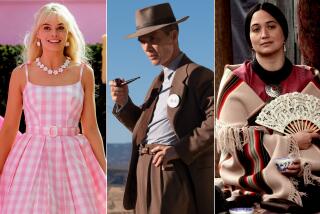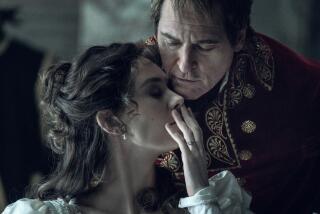Tavernier and Noiret: Soldiers of Fortune : Film: Director and actor join forces in ‘Life and Nothing But’ to trace the fate of 350,000 French troops after World War I.
- Share via
“Life and Nothing But” has brought director Bertrand Tavernier and actor Philippe Noiret to the pinnacles of their careers, which are very high indeed. Tavernier’s “ ‘Round Midnight,” set in the Paris jazz scene, and Giuseppe Tornatore’s “Cinema Paradiso,” in which Noiret played the fatherly small-town projectionist, are not only their most recent films seen in America but also their biggest international successes.
Now, they have teamed for the fifth time, with Noiret portraying a formidable but lonely officer obsessed with accounting for the 350,000 French soldiers missing in action at the end of World War I. “Life and Nothing But” is set primarily on the battlefield of Verdun in 1920 and involves an elegant woman (Sabine Azema) searching for her husband. The heart of the matter is the unexpected impact this man and woman have upon each other.
“The film has been a great success everywhere it has played--and that is my revenge, because it was so difficult to get financing,” said Tavernier, during a recent visit to Los Angeles with Noiret to promote the film. “I’ve wanted to do this film since Philippe and I made ‘Coup de Torchon.’ We were making that film in this very small town in Senegal, and we met the president of their World War I veterans organization.
“He was 82 or 83 at the time and told us incredible stories about that period. He stayed in Verdun and in the east of France one or two years after the war. He told us about the women who would come to the battlefield searching for their husbands or brothers or fathers or at least some token of them. This image stayed in my mind. Then one day I read in a book that in 1920 there were still 350,000 soldiers missing in action! That’s the equivalent of the total number of men in the French army today!
“How did they go about trying to find these missing persons? How did they find clues? What if a man was an amnesiac or a deserter? How did they choose the Unknown Soldier for burial at the Arc de Triomphe? When I learned that they took only three days to do this, it gave me and my writer Jean Cosmos a time period, a shape. From this we could build the film emotionally.”
Tavernier said that he and Cosmos saw it as more as a story about life than death, about the process of rediscovering peace and happiness.
“I knew it would be full of life, hope, energy,” Tavernier said. “We made a list of characters. One of them, a minor character, was an officer in charge of the search for the dead. For me, he was the hero, someone obsessed, living in the world of death, fighting against the Establishment, trying to prevent people from forgetting. This character came out from the background and imposed himself.”
Tavernier said he saw the part as sort of an American Western hero, like John Wayne in “The Searchers,” and that it was written with Noiret in mind, even though it was unlike anything the actor had done in more than 100 films. Noiret was game for the challenge.
“Bertrand brought all the drafts to me at my country home,” said Noiret. “Of course, I said yes. ‘When do you want to do it?’ For me, it is first the script, then the character, and I was very, very happy to be working with Bertrand again. Also to have something with a bit of romance, passion. I will be 60 in a few months, maybe it’s my last romantic part.”
It was Noiret who made it possible for Tavernier, a former publicist and historian, to become a film director. In the early ‘70s, Tavernier sent Noiret an adaptation of Georges Simenon’s “The Clockmaker of St. Paul,” which he had co-written with Jean Aurenche and Pierre Bost, and when Noiret agreed to star in it, Tavernier got his first directing job. The film was released in 1974.
The two men have worked so often together since that they communicate almost by shorthand.
“Let’s say that I don’t have to explain motivation for the character for 45 minutes to Philippe before we can begin the scene,” said Tavernier. “I don’t know why directing actors has to be difficult. . . . We have fun, but that doesn’t mean we don’t work hard.”
“All discussion should be (conducted) long before the shooting,” added Noiret. “So many crises on the set have less to do with filmmaking than with power. You feel no amour-propre , no shame with Bertrand. You can be free. He will tell you if you’re not going in the right direction.”
“I don’t want people to be afraid to look stupid, and I want the right to make mistakes,” said Tavernier. “Everybody should get into the soul of the film.”
Since completing “Life and Nothing But” over a year ago, Tavernier has completed “Daddy Nostalgy,” a family drama starring Dirk Bogarde and Jane Birkin and inspired by Tavernier’s former in-laws. The busy Noiret has made three films, including a sequel to the hit police comedy “My New Partner,” and will next reteam with Italian director Giuseppe Tornatore.
Noiret will also co-star with countryman Gerard Depardieu in Claude Berri’s adaptation of Marcel Ayme’s “Uranus.” As for now, Tavernier and Noiret, whose films together have all been marked by complexity and intense emotional impact, have no plans to work together again. “It’s too soon,” said Tavernier. “We need a break,” added Noiret.
More to Read
Only good movies
Get the Indie Focus newsletter, Mark Olsen's weekly guide to the world of cinema.
You may occasionally receive promotional content from the Los Angeles Times.










